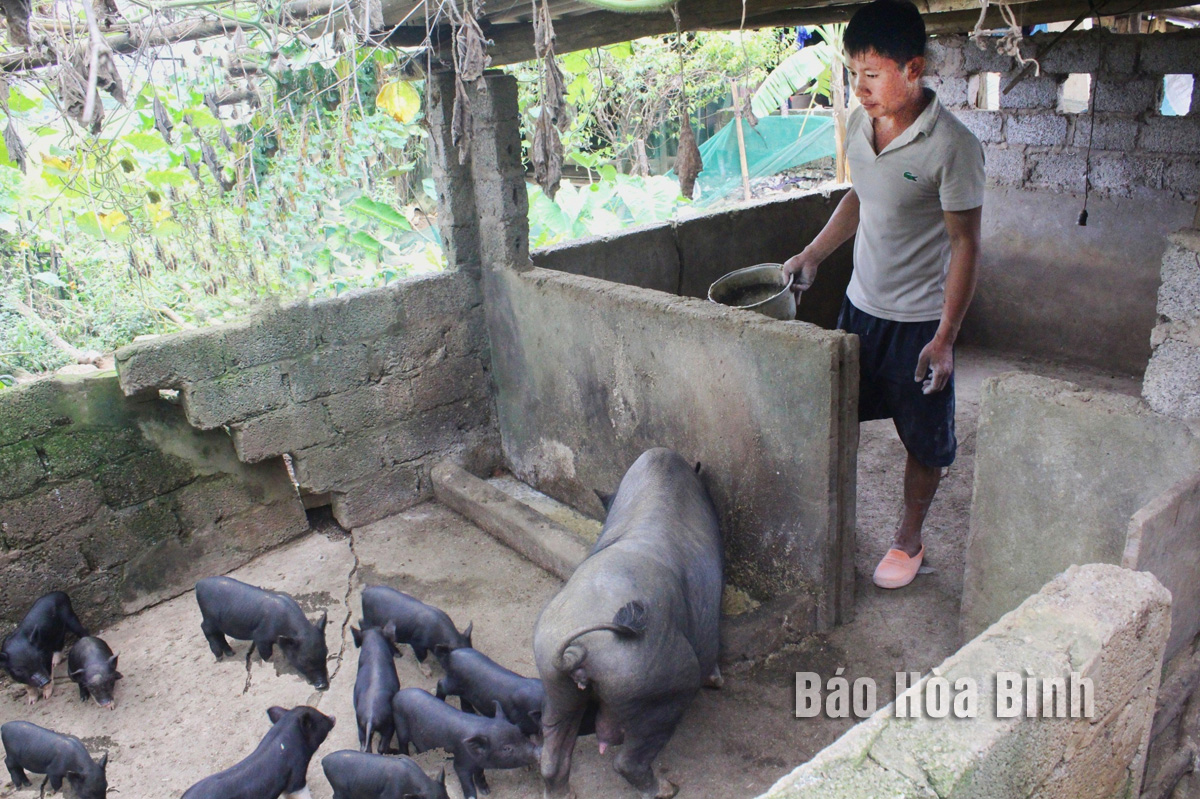
(HBO) - In recent years, rasing the native pigs has been paid attention to by many households in the highland district of Da Bac. This is not only suitable for the local conditions, but it also brings good economic efficiency.
The households in Khem hamlet, Doan Ket commune (Da Bac) have been raising black indigenous pigs to bring in good income.
The indigenous black pig is a pig breed that produces delicious meat, suitable for farming conditions in the highland areas, where there is abundant grazing area and food sources. In the highland district of Da Bac, since ancient times, the black pigs of small size have been raised by the people for improving the life. In the past, pigs were often raised freely throughout the gardens and the hills, mainly for improvement and it was not considered as the livestock that brought in income. In recent years, the price of the black pigs has always remained high, and the market favors them, so many households in Da Bac district have built barns to raise indigenous black pigs.
In Doan Ket commune, raising indigenous black pigs is an economic development direction that people have been paying attention to. Currently, many households raise this livestock with a scale of several dozen animals. For instance, Mr. Lo Van An's family in Khem hamlet raises 5 sows and dozens of pigs for meat. According to Mr. An, in the past, his family only raised 1-2 sows, and then raised the small pigs when sows gave birth as many as they could. The family used the garden behind the house to raise pigs. After being raised for 7, 8 months to 1 year old, they were sold, the price was always stable at over 100 thousand VND/kg. Realizing that the market demand is high and the price is stable, Mr. An’s family has built a black pig breeding area with a quantity of 5-6 sows. Currently, the average selling price is 120 thousand VND/kg, bringing a significant source of income for the family.
While Mr. An's family has maintained raising indigenous black pigs for many years, recently, many households in Doan Ket commune have focused on expanding the scale of raising this breed of pig in the direction of goods. Forr instance, Mr. Lo Van Tuat's family in Khem hamlet built a barn to raise black pigs in large numbers last year. Mr. Tuat says: We have a large garden and hill land, so we are planning to build an area of about 1 hectare to raise black pigs. This breed of pig is quite healthy, resistant to disease, omnivorous so it is easy to raise. In particular, it is not only sold to traders outside the district, but there is great demand within the district, especially in the tourism areas.
Not only in Doan Ket commune but also in most highland communes in Da Bac district, they have also been paying attention to raising indigenous black pigs. In Trung Thanh commune, some households have decided to focus on raising indigenous pigs to increase their income. "Here, people grow corn, cassava, and forests. Those are the most favorable conditions for raising black pigs. In the past, the output was difficult, but now the travel is convenient so the consumption is easier. The people in the village can transport pigs to Hoa Binh city for consumption in just 1 hour,” says Mr. Ha Van Huongn from So hamlet, Trung Thanh commune.
In addition to promoting commodity-oriented indigenous pig farming, the district has been focusing on building a chain of links in raising and consuming black pigs. Typically, in Tan Minh commune, the households ráiing indigenous black pigs have linked up and established the cooperatives to purchase indigenous pork. Currently, the products of Tan Minh pork are packaged, have traceability stamps and are recognized as 3-star OCOP products. According to the leaders from the Department of Agriculture and Rural Development of Da Bac district, in recent years, there are over 23 thousand native pigs maintaining and raising in over 3 thousand households in Da Bac district.
The indigenous black pigs are raised freely, the food is mainly made from agricultural by-products or naturally available food without antibiotics or growth stimulants, and the raising time is long so the meat quality is good. Currently, the district is implementing the policies supporting the development of indigenous pig farming, such as supporting the purchase of indigenous pig breeds from the capital of the National Target Program for the Socio-Economic Development of Ethnic Minority Areas and mountainous region.
In Lac Thuy district, communes have been succeeded in promoting their One Commune-One Product (OCOP) products while others are still struggling to position their typical farming products in market. Some communes in the district still fail to have their products met OCOP programme’s requirements, while others have seen their certifications expired.
The inspectorate agency of Hoa Binh province has issued Official Dispatch No. 1090/TTr-PCTN to provincial departments, agencies, localities, business associations, enterprises, and investors regarding measures to improve informal component indexes of the Provincial Competitiveness Index (PCI).
Hoa Binh is taking concrete steps to improve its investment environment, with a strong focus on supporting businesses, settling obstacles for strategic investors, and creating opportunities for robust development in the coming years.
Under the blazing early summer sun, the construction site of Nhuan Trach Industrial Park (IP) in Luong Son district is abuzz with activities from dawn to dusk, a testament to the determination of the investor to meet their construction targets on schedule.



